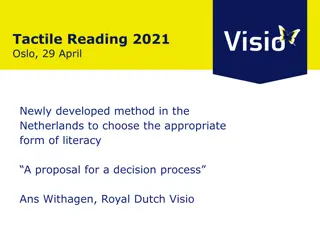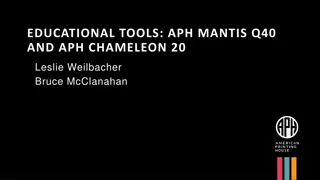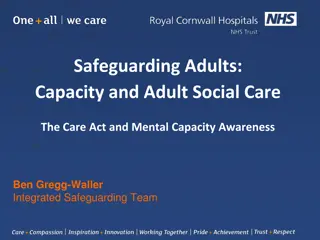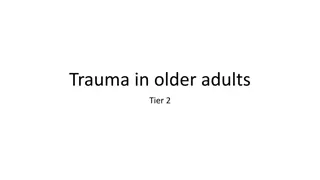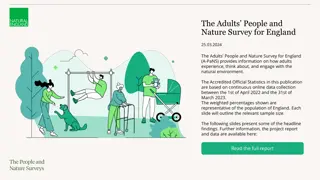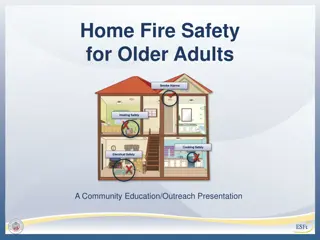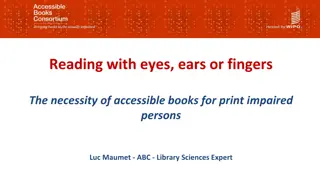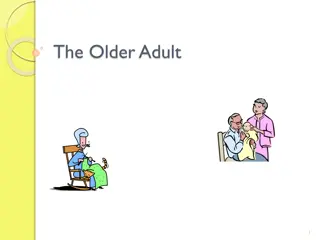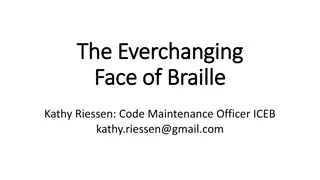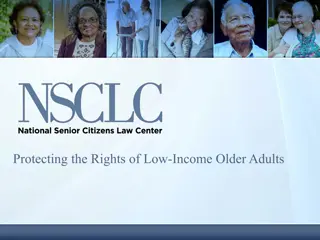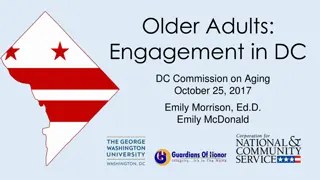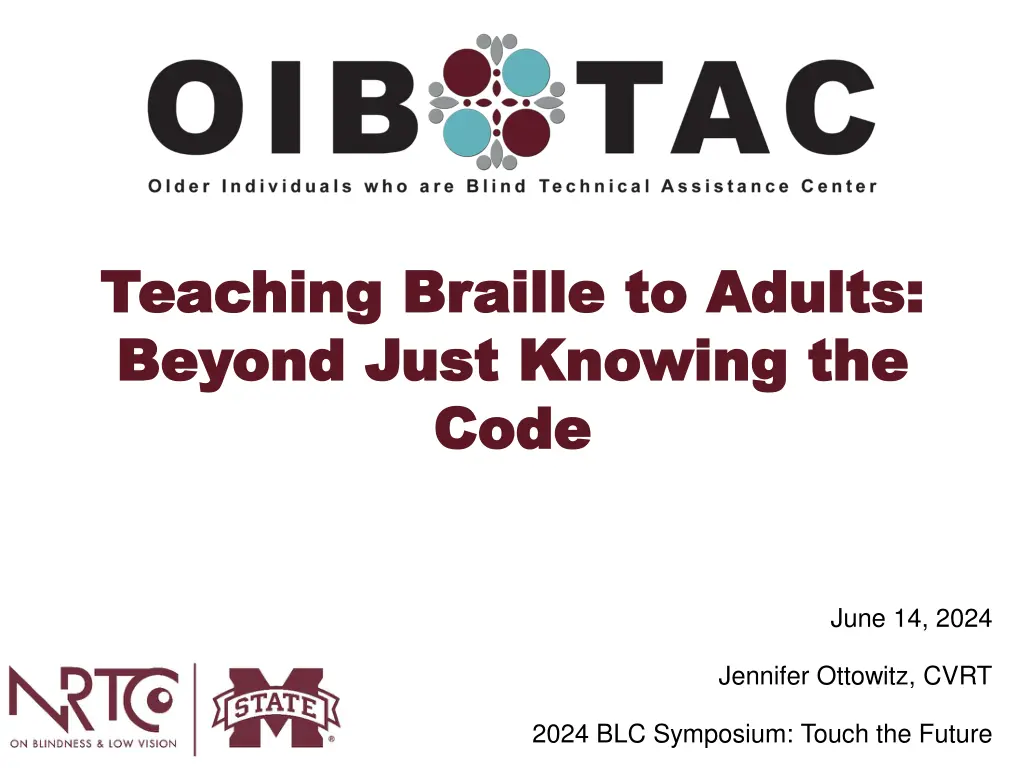
Teaching Braille to Adults: Enhancing Literacy Skills
Discover the Teaching Braille to Adults course by the National Research and Training Center on Blindness and Low Vision. Learn how to address misconceptions, apply adult learning theory, and make braille learning relevant. Explore modules covering learning styles, foundational skills, reading, writing, and more.
Download Presentation

Please find below an Image/Link to download the presentation.
The content on the website is provided AS IS for your information and personal use only. It may not be sold, licensed, or shared on other websites without obtaining consent from the author. If you encounter any issues during the download, it is possible that the publisher has removed the file from their server.
You are allowed to download the files provided on this website for personal or commercial use, subject to the condition that they are used lawfully. All files are the property of their respective owners.
The content on the website is provided AS IS for your information and personal use only. It may not be sold, licensed, or shared on other websites without obtaining consent from the author.
E N D
Presentation Transcript
Teaching Braille to Adults: Teaching Braille to Adults: Beyond Just Knowing the Beyond Just Knowing the Code Code June 14, 2024 Jennifer Ottowitz, CVRT 2024 BLC Symposium: Touch the Future
Objectives Objectives Describe the Teaching Braille to Adults course offered by the National Research and Training Center On Blindness and Low Vision. Identify how to positively address misconceptions about learning braille. Explain how adult learning theory can be incorporated into assessment and instruction. PAGE 2
How do you introduce the topic How do you introduce the topic of braille to your clients? of braille to your clients? PAGE 3
Present braille as a means to Present braille as a means to solve a problem or meet a goal. solve a problem or meet a goal. PAGE 4
NRTC Course NRTC Course Bringing It All Bringing It All Together Together Teaching Braille to Adults course For those who already know the braille code and are teaching adults. Presents assessment and instructional strategies for reading and writing braille. Discusses strategies to keep learners motivated during the learning process. Gives ideas for customizing instruction for individuals with unique learning needs and other comorbidities. PAGE 5
Teaching Braille to Adults Course Teaching Braille to Adults Course Module 1: Learning Styles and Motivation Module 2: Foundational Braille Skills Module 3: Teaching Braille Reading Basic Concepts Module 4: Teaching Braille Writing Module 5: Learners With Additional Needs Module 6: Increasing Braille Reading Speed PAGE 6
Address Misconceptions Address Misconceptions Braille is a tool for literacy that can be used by people with remaining vision and not just for those who are blind. Braille can be useful for people with functional goals and not just for those interested in doing extensive reading. Learning braille isn t something to be ashamed of. PAGE 7
Need for Relevancy Need for Relevancy Learning should help solve a need or problem. Learning should be practical and immediately usable. PAGE 8
How Braille Can Be Helpful How Braille Can Be Helpful Socializing with others by playing cards or games. Participating in a community or faith-based group by performing reading and writing tasks. Increasing independence with daily living tasks. Increasing access to information and privacy. Expanding recreational and educational opportunities. Improving efficiency with job tasks. PAGE 9
Adults Are Adults Are Problem-centered Result-oriented Self-directed learners More skeptical Internally motivated PAGE 10
With Adults With Adults Focus is on: Mechanics of successful braille reading. Attaching learning to meaningful life goals. PAGE 11
Additional Considerations for Adults Additional Considerations for Adults Need to give relevant and motivating opportunities to develop tactile recognition along with proper finger and hand movements. Acknowledge and draw on life experiences to make learning relatable and build collaboration. Be aware of how past literacy experiences influence interest and enthusiasm. Recognize that past learning experiences could be positive or negative and impact motivation and confidence. Tap into what motivates them to reinforce learning. PAGE 12
Questions to Ask During Assessment Questions to Ask During Assessment What kinds of things did you read before losing vision? How do you see yourself using braille? What are some of your reading and writing goals? In school, was reading easy or hard for you? What strategies have helped when you learn something new? (hands-on activities, quizzes, study notes, etc.) What do you enjoy reading? Do you have favorite authors? PAGE 13
Questions to Ask During Instruction Questions to Ask During Instruction How do you think you re doing? Are there activities or materials we re using that you find helpful? Are there things that aren t working well? Are there areas in which you d like more practice or support? How have you been able to use braille in your daily activities? PAGE 14
Customizing Instruction Customizing Instruction Adaptations for reading Adaptations for writing PAGE 15
Choosing An Approach Choosing An Approach Match to learner s goals Uncontracted or contracted braille Order of symbols and when to introduce contractions Identify learner s reading level Formal curricula, homemade materials, or I-M-ABLE approach PAGE 16
I I- -M M- -ABLE ABLE Individualized Meaning-Centered Approach to Braille Literacy Education Learner selects meaningful words to learn as tactile sight words. Initially use word length and tactile characteristics for identification. Gradually move to a skills-based approach with letter recognition and phonics. PAGE 17
Helpful Tips Helpful Tips Vary instructional strategies; short, varied activities are best. Draw on learner s visual memory to help them make associations with symbols. Don t push for advancement until learner is ready; build in success experiences for confidence. Begin with high-interest, low-vocabulary materials then increase complexity and vary formats. Use materials and practice activities that are motivating to the individual learner. PAGE 18
Instruction Should Include: Instruction Should Include: Letting learners know about their progress. Reminding them of their goals and how current tasks relate to them. Documenting progress in measurable, specific terms. Giving opportunities to practice during instruction. Giving homework/encouraging practice outside of lessons. Sharing resources so skill development continues after formal instruction. PAGE 19
Assessing Progress Assessing Progress Miscue analysis Cloze procedure Observation Assessing reading speed PAGE 20
Addressing Issues Addressing Issues Symbol/contraction recognition Reversals/inversions Scrubbing Tracking issues Forgetting what was read PAGE 21
Braille is knowledge, and Braille is knowledge, and knowledge is power. knowledge is power. Braille Braille Louis Louis PAGE 22
Questions? Questions? PAGE 23
The Older Individuals who are Blind Technical Assistance Center (OIB-TAC) is a development of the National Research & Training Center on Blindness and Low Vision (NRTC) at Mississippi State University, focused on agencies serving older individuals who are blind. This grant (H177Z200001) is funded by the Rehabilitation Services Administration (RSA) under the U.S. Department of Education. PAGE 24
Jennifer Ottowitz jottowitz@colled.msstate.edu 662-325-2001 For more information, please contact: For more information, please contact: OIB-TAC: www.oib-tac.org www.oib-tac.org P.O. Box 6189 205 Morgan Avenue Mississippi State, MS 39762 P. 662.325.2001 NRTC: blind.msstate.edu blind.msstate.edu ntac.blind.msstate.edu www.facebook.com/theNRTC www.twitter.com/MSU_NRTC ntac.blind.msstate.edu www.facebook.com/theNRTC www.twitter.com/MSU_NRTC PAGE 25

